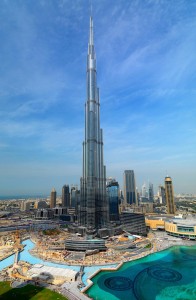By Maurice Picow www.greenprophet.com
We covered the grand opening ceremony of Dubai’s Burj Khalifa Tower, formerly called Burj Dubai. But amidst all the fireworks and fanfare, does this 818 meter high monument to human engineering achievement represent any innovations towards combating global warming, climate change, or other environmental breakthough – or is it simply another “Tower of Babel,” constructed by misguided human beings still trying to build us a city and a tower with its top in heaven?

The newly completed tower is certainly impressive; with 158 usable stories, more than 50 super fast elevators, and a ground floor foyer that will house the world’s largest indoor fountain. The tower is expected to attract visitors from around the world as well as host a variety of high profile conventions and conferences.
Taking all of this into account, we must also consider the environmental ramifications of this structure which took six years to build, at a cost of more than 4 billion USD, The project’s designers claim that the building and its planned botanical gardens and series of man-made lakes were designed to be as environmentally sustainable as possible, when one takes into account that Dubai is located in a part of the world that has very scanty rainfall and some of the hottest summers on the planet.
It was constructed to withstand the extreme temperature ranges of this Persian Gulf city-state, where external temperatures during the summer can average more than 50 degrees C (122 degrees F).
Another possibly favorable ecological “by-product” of the massive edifice is the large amount of water produced by condensation and so far collected from the air conditioning systems used to keep the entire structure pleasantly cool (estimated at around 15,000 liters), and will be used to provide water for the garden complex that will eventually surround the tower.
The question many may have, however, is what fuel sources are being used to provide the electricity that powers the AC system as well as all the lighting and elevators needed therein?
Mohamed Alabbar, Chairman of Emaar Properties, the development company behind this project was quoted recently as saying: “Burj Khalifa is the Arab World’s tribute to the art and science of modern engineering and design. Burj Khalifa symbolizes the aesthetic union of many cultures – from Arabia and the rest of the world.”
For years now, Dubai has been trying to show the world that this little UAE sheikhdom of less than 4 million people (including guest workers) has the world’s most impressive city from an architectural standpoint. Judging from past projects in this showcase Persian Gulf city-state, such as the ultra luxurious Atlantis Hotel Complex, the largest indoor ski slope in the world, and a series of off-shore island projects, including Palm Island and The World (whose ultra high debt crises is the basis for Dubai’s current financial morass), the completed tower could not have been finished at a more problematic time; both environmentally as well as from a financial standpoint.













